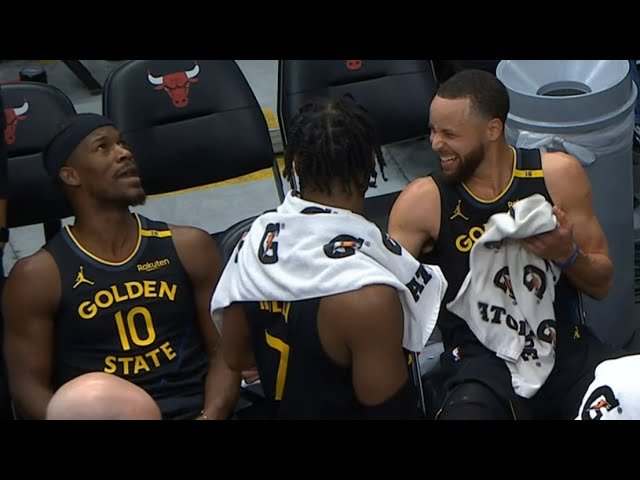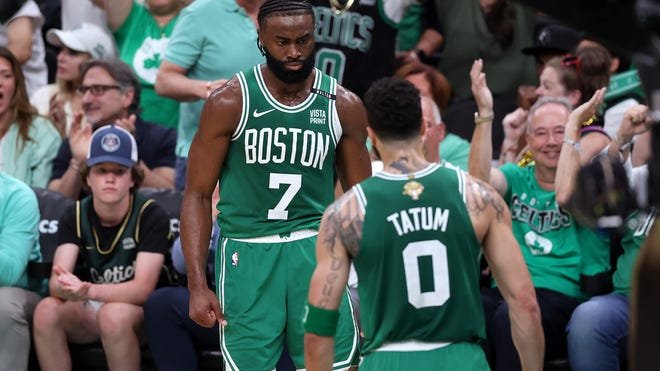
It would be anticipated that the initial play the Golden State Warriors implement with Jimmy Butler would involve positioning him in the low post — possibly after he sets a screen for himself or sets a screen for a teammate to induce a switch from a smaller defender. That would be the most logical way to help him adjust to the Warriors’ offense, while also making things easy and clear. In addition, the possibility of Butler making a score over a shorter defender would compel the defense to respond in numerous ways.
Nonetheless, although Butler did bring down the ball during the first set of the game, it was not he who completed the play. Instead, Steve Kerr opted for a twist on the usual pick-and-roll formation, initiated with some decorative movement, leading to a three-pointer by Buddy Hield:
An “out” screen for Steph Curry, who passes the ball back to Butler (known as “Touch” action) while moving to the other side, serves as the façade for the core of the play: Hield moving in to set a backscreen for Draymond Green after Green sets a ball screen for Butler, followed by Hield popping out to present himself as an option beyond the arc. This play — known as a “Spain” or “Stack” pick-and-roll — sets up a shot for Hield, who quickly sinks the three-pointer.
Although this contradicts Kerr’s earlier intention to simplify matters for Butler, who is new to the team and still learning play calls and terms, it offers insight into the different methods the Warriors can utilize Butler. His menace as a downhill scorer causes defenses to reconsider their approach to ball screens, even though he lacks a reputation as an effective pull-up shooter on the move. This reality alone turns the “Spain” pick-and-roll into a danger; it capitalizes on how teams typically have their big men retreat into the paint during a Butler ball-screen play, rendering those bigs more susceptible to backscreens from shooters like Hield.
Beyond Butler’s usage while on the ball, it was how the Warriors utilized him off the ball that stood out. One element of Butler’s offensive game that isn’t as frequently highlighted in mainstream discussions — yet is equally crucial as his other contributions on offense — is his readiness and efficiency as a screener.
In particular, Butler’s initial offensive screens were notable against the Chicago Bulls. Even on plays where he doesn’t handle the ball, the Bulls’ defense responds considerably at the thought of 6’5” Coby White needing to guard the 6’7” Butler, who holds a 35-pound weight edge. Consequently, the Bulls opt to assign an additional defender to stack the strong side in response to the Butler post-up.
Rather than passing the ball to Butler, Moses Moody opts to skip it to Brandin Podziemski in the corner on the weak side, which is unguarded because the defender went to assist against Butler. Thanks to a pin-in screen from Kevon Looney, Podziemski elevates his defender and nails the three-pointer:
In a related observation, Butler receiving the ball in the post after screening — thus creating a favorable matchup — compels the help defense on the weak side to decide. Noticing that White is struggling against Butler in the left block, Nikola Vučević moves to assist — but this results in Quinten Post being left open in the corner. Butler thus passes the ball to Post:
What had primarily been a singular approach by the Warriors — that singular focus being Steph Curry — transforms into a more balanced and harmonious scenario thanks to the versatility that Butler provides as a screener. Various strategies for attack can be initiated, like this early offensive butt screen by Butler that compels Matas Buzelis (20 pounds lighter) to switch onto Butler, who then takes Buzelis into the paint and effortlessly shoves him aside to achieve an open shot under the rim:
When those attempted switches come a bit late or are otherwise mishandled, Butler can swiftly navigate to the paint to capitalize on top-side positioning:
Butler’s systematic strategy for identifying the mismatch and dismantling his opponent applies even when he’s off the ball. Although Kevin Huerter stands the same height as Butler at 6’7″, he weighs almost 45 pounds less. Butler can maneuver Huerter as though he were a puppet — this also allows him to achieve the right positioning beneath the basket. Joined with a passer like Green, Butler serves as a lethal asset for the Warriors, a team facing challenges with scoring around the rim this season.
Butler’s exceptional basketball intelligence and capacity to serve both as the final element and the unifying factor enable him to integrate effortlessly into this framework that, at times, appears to lack any rigid organization. When situations seem poised to descend into stagnation, Butler can ensure the game continues and teammates receive favorable opportunities.
It also serves as evidence of Butler’s high intelligence that he can immediately identify patterns on the court and respond appropriately. He watches the ball directed to Green in the post and promptly looks for Curry to establish a screen in split action. Butler gets hit and creates the foul — yet the reality that he immediately understands to set a screen for Curry in his debut as a Warrior is a highly positive sign of his compatibility.
It is also beneficial that he has a good understanding of the split action concept, having implemented different versions of it while with the Miami Heat.
In the end, Butler’s greatest contribution is his capacity to serve as the desired scoring aid alongside Curry, who emerged from his slump in the game against the Bulls: 34 points on 10-of-19 shooting (8-of-16 from three) and a True Shooting percentage of 75.5%. Trailing him was Butler’s 25 points from 7-of-12 shooting and a 70.5% True Shooting percentage — highlighted by his impressive 11-of-13 performance at the free-throw line.
Butler is not just an eager scorer near the rim — he frequently drives to the basket with his aggressive plays. At the beginning of the game, Curry quickly tried to create an inverted ball screen for Butler, who declined the screen and earned two free throws:
For a team that ranks among the worst in the league in free throw attempts per 100 possessions (27th), free throw percentage (30th), and field goal percentage in the restricted area (20th), Butler is a much-needed blessing:
Although the game wasn’t flawless or free from a possible embarrassment — the Warriors trailed by as many as 25 points to a team that recently traded Zach LaVine — Curry and Butler staged a 24-3 run in a five-minute span to turn the game around. The Bulls may not be the toughest opponents, but witnessing the Warriors show a spark of potential through the Curry-Butler duo is a notable takeaway.
This doesn’t imply that the Warriors are guaranteed a legitimate playoff spot, much less a significant advance into the Western Conference’s elite group of contenders. Don’t be mistaken: Butler is a both a current win acquisition and a future investment. However, considering how the Warriors have wasted this season, the latter offers a much clearer route than the former.
It has also been made evident: Butler is a good fit for this team. More significantly, he complements Curry, a complete contrast that demonstrates how both extremes of the offensive spectrum draw together and can effectively coexist.


